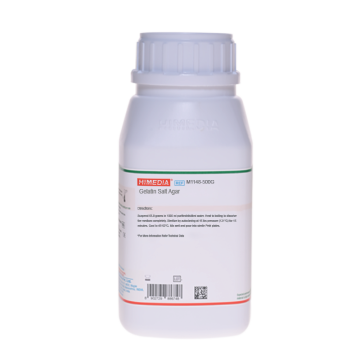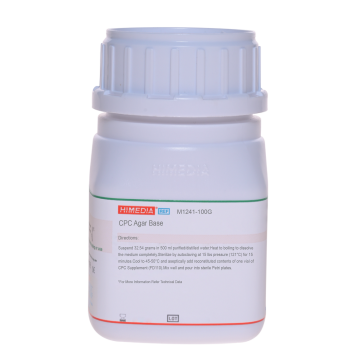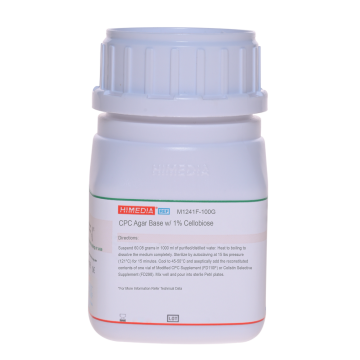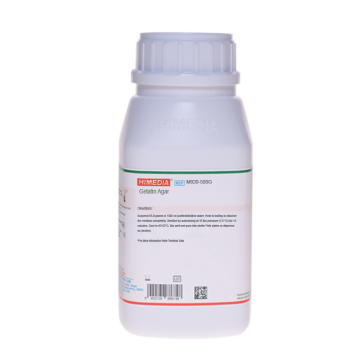 Your enquiry has been submitted
Your enquiry has been submitted
Arginine-Glucose Yeast extract Agar
Intended Use
Recommended for screening and confirmation of Vibrio species in accordance with FDA BAM, 1998
Composition**
| Ingredients | Gms / Litre |
|---|---|
| Peptone | 5.000 |
| Yeast Extract | 3.000 |
| Tryptone | 10.000 |
| Sodium Chloride | 20.000 |
| Dextrose (Glucose) | 1.000 |
| L-Arginine hydrochloride | 5.000 |
| Ferric ammonium citrate | 0.500 |
| Sodium thiosulphate | 0.300 |
| Bromocresol purple | 0.020 |
| Agar | 13.500 |
Final pH ( at 25°C): 6.9±0.1
**Formula adjusted, standardized to suit performance parameters
Directions
Suspend 58.32 grams in 1000 ml purified / distilled water. Heat to boiling to dissolve the medium completely. Dispense in 5 ml amount into test tubes and sterilize by autoclaving at 15 lbs pressure (121°C) for 10-12 minutes. Cool to 45-50°C and allow the medium to set in a sloped form giving butt and slant.
Principle And Interpretation
Vibrio species are asporogenus, motile rods with polar flagella. Amongst the different species V. cholerae, V. parahaemolyticus, V.vulnificus and V. mimicus are well-documented human pathogens especially in intestinal diseases such as cholera, whereas V. alginolyticus, V. fluvialis, V. furnissii, V. metschnikovii and V. hollisae are reported to be opportunistic pathogens. Arginine-Glucose Yeast Extract Agar is used for the screening and confirmation of Vibrio species from food specimens in accordance with FDA BAM (4).
Peptone, Tryptone and yeast extract provide the necessary carbonaceous, nitrogenous compounds, long chain amino acids and vitamin B complex to the organisms. Dextrose (Glucose) acts as the fermentable carbon source. Ferric ammonium citrate and sodium thiosulphate are the indicators for H2S production and bromocresol purple acts as the pH indicator. This medium contains L- Arginine HCl. The organisms which do not decarboxylate L- Arginine HCl but ferment glucose, gives an alkaline slant and an acid butt (3).
Inoculate the suspect culture identified through presumptive method to the Arginine-Glusose Yeast Extract Agar slants by streaking and stabbing the butt. Incubate it with loose cap overnight at 35° ±2°C. Organisms that ferment glucose produce a variety of acids, turning the colour of the medium from purple to yellow. More amounts of acids are liberated in butt (fermentation) than in the slant (respiration). Growing bacteria that can hydrolyse Arginine give more alkaline products that neutralize the acid present in the butt making the medium purple. V. cholera, V. mimicus, V. parahaemolyticus and V. vulnificus cultures will have an alkaline (purple) slant and an acid (yellow) butt, as arginine is not hydrolyzed. Whereas V. fluvialis, V. furnissii and V. hollisae show positive arginine hydrolysis indicated by the purple slants and butt. No gas or H2S is produced by any of the organisms.
Type of specimen
Food samples
Specimen Collection and Handling
For food samples, follow appropriate techniques for sample collection and processing as per guidelines (5). After use, contaminated materials must be sterilized by autoclaving before discarding.
Warning and Precautions
Read the label before opening the container. Wear protective gloves/protective clothing/eye protection/ face protection. Follow good microbiological lab practices while handling specimens and culture. Standard precautions as per established guidelines should be followed while handling specimens. Safety guidelines may be referred in individual safety data sheets.
Limitations
- Due to nutritional variations certain strains may show poor growth.
Quality Control
Appearance Light yellow to greenish yellow homogeneous free flowing powder
Gelling Firm, comparable with 1.35% Agar gel.
Colour and Clarity of prepared medium Purple coloured clear to slightly opalescent gel forms in tubes as slants with a butt.
Reaction Reaction of 5.83 % w/v aqueous solution at 25°C. pH : 6.9±0.1
pH 6.80-7.00
Cultural Response Cultural characteristics observed after an incubation at 33-37°C for 18-24 hours.
| Organism | Inoculum (CFU) | Growth | Slant | Butt | Gas | H2S |
|---|---|---|---|---|---|---|
| Vibrio cholerae ATCC 15748 | 50-100 | luxuriant | Alkaline reaction, Purplish colour | acidic reaction, yellowing of the medium | negative reaction | negative reaction, no blackening of the medium |
| Vibrio parahaemolyticus ATCC 17802 (00037*) | 50-100 | luxuriant | Alkaline reaction, Purplish colour | acidic reaction, yellowing of the medium | positive reaction | negative, no blackening of medium |
| Vibrio vulnificus ATCC 29306 | 50-100 | luxuriant | Alkaline reaction, Purplish colour | acidic reaction, yellowing of the medium | positive reaction | negative, no blackening of medium |
| Vibrio fluvialis ATCC 33809 (00137*) | 50-100 | luxuriant | Alkaline reaction, purplish colour | acidic reaction, yellowing of the medium | positive reaction | negative, no blackening of medium |
Key : (*) Corresponding WDCM numbers.
Storage and Shelf Life
Store between 10-30°C in a tightly closed container and the prepared medium at 20-30°C. Use before expiry date on the label. On opening, product should be properly stored dry, after tightly capping the bottle in order to prevent lump formation due to the hygroscopic nature of the product. Improper storage of the product may lead to lump formation. Store in dry ventilated area protected from extremes of temperature and sources of ignition. Seal the container tightly after use. Product performance is best if used within stated expiry period.
Disposal
User must ensure safe disposal by autoclaving and/or incineration of used or unusable preparations of this product. Follow established laboratory procedures in disposing of infectious materials and material that comes into contact with sample must be decontaminated and disposed of in accordance with current laboratory techniques (1, 2).
Reference
- Isenberg, H.D. Clinical Microbiology Procedures Handbook 2nd Edition.
- Jorgensen, J.H., Pfaller, M.A., Carroll, K.C., Funke, G., Landry, M.L., Richter, S.S and Warnock., D.W. (2015) Manual of Clinical Microbiology, 11th Edition. Vol. 1.
- Murray PR, Baron EJ, Jorgensen JH, Pfaller MA, Yolken RH. Manual of Clinical Microbiology. 8 ed. Washington, D.C:ASM; 2003.
- US FDA. Bacteriological Analytical Manual. 18 ed. Washington, DC: AOAC; 2005.
- Salfinger Y., and Tortorello M.L. Fifth (Ed.), 2015, Compendium of Methods for the Microbiological Examination of Foods, 5th Ed., American Public Health Association, Washington, D.C.
| Product Name | Arginine-Glucose Yeast extract Agar |
|---|---|
| SKU | M1869 |
| Product Type | Regular |
| Physical Form | Powder |
| Origin | Animal |
| Packaging type | HDPE |
| References | 1.USFDA. Bacteriological Analytical Manual. 18 ed. Washington, DC: AOAC; 2005.2.Murray PR, Baron EJ, Jorgensen JH, Pfaller MA, Yolken RH. Manual of Clinical Microbiology. 8 ed. Washington, D.C:ASM; 2003. |
| Customized Product Available | No |











